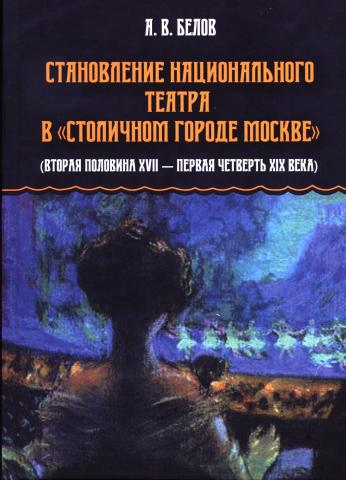Белов, А. В. Становление национального театра в «столичном городе Москве» (вторая половина XVII — первая четверть XIX века) / А. В. Белов. — Москва; Берлин : Директмедиа Паблишинг, 2022. — 480 с.; ил. ISBN 978-5-4499-2534-3
Конец XVII — первая четверть XIX в. — время зарождения и становления в Москве общедоступного национального театра. Этот отрезок заключает в себе период от первых попыток русских царей организовать в городе сценическое действо на европейских основах до открытия «Большого Петровского» (ныне — Большого) театра, ставшего символом и вехой не только московской, но и общероссийской, а позже и явлением общемировой театральной культуры.
Несмотря на значение данного отрезка для становления театральной культуры в истории как Москвы, так и всей страны, он не был рассмотрен как единый процесс, находившийся в прямой зависимости от целого ряда факторов и обстоятельств, порожденных как его собственными особенностями, так и характером исторического времени и места.
Наряду с становлением театра в книге изучаются проблемы функционирования в городе крепостных сценических коллективов, являвшихся единым целым с культурной средой города тех лет и внесших значительный вклад в общий процесс театрального строительства как Первопрестольной, так и всей страны. Уделяется внимание проблеме управления театром, деятельности театральной администрации (как в мирные, так и в военные годы), ее вклад в сохранение и развитие театральной жизни в Москве, особенностям подготовки и проведения постановок, языку сцены, взаимодействию театра и зрителя.
В приложении приводятся документы, знакомство с которыми предоставляет возможность увидеть внутреннюю жизнь московского театра рассматриваемого периода; почувствовать царящую в нем атмосферу; помогает составить представление о процессе функционирования театрального механизма; наполняет живым содержанием имена творцов и участников театрального действа давно ушедшего времени.
Исследование выполнено при финансовой поддержке РФФИ в рамках научного проекта № 18-09-00047.
Late 17 th — first quarter of the 19 th century was the time of the birth and formation of a publicly available national (“Russian”) theater in Moscow. This segment includes the period from the first attempts of the Russian tsars to organize a stage performance in the city on a European basis, to the opening of the Bolshoi Petrovsky (now the Bolshoi) theater, which became a symbol and milestone not only for Moscow, but also for the All-Russian culture, and later also for the worldwide theater.
Despite the significance of this segment for the formation of theatrical culture in the history of both Moscow and the entire country, it was not considered as a single process, which was directly dependent on a number of factors and circumstances generated both by its own characteristics and the nature of historical time, and places.
Along with the formation of the theater, the book examines the problems of the functioning of serf stage groups in the city, which were a single whole with the cultural environment of the city of those years and made a significant contribution to the overall process of theatrical construction of both the “First Capital" and the entire country. Attention is paid to the problem of theater management, the activities of the theater administration (both in peace and war years), its contribution to the preservation and development of theatrical life in Moscow, the specifics of preparing and conducting performances, the language of the stage, the interaction between the theater and the audience.
The appendix contains documents, familiarity with which provides an opportunity to see the inner life of the Moscow theater of the period under review; feel the atmosphere reigning in it; helps to get an idea of the process of functioning of the theatrical mechanism; fills with living content the names of creators and participants in theatrical performances of a long-gone time.







